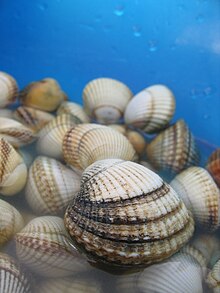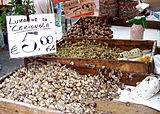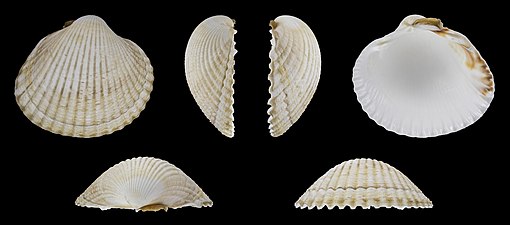| Common cockle | |||
|---|---|---|---|

| |||
| Scientific classification | |||
| Domain: | Eukaryota | ||
| Kingdom: | Animalia | ||
| Phylum: | Mollusca | ||
| Class: | Bivalvia | ||
| Order: | Cardiida | ||
| Family: | Cardiidae | ||
| Genus: | Cerastoderma | ||
| Species: | C. edule | ||
| Binomial name | |||
| Cerastoderma edule (Linnaeus, 1758) | |||
| Synonyms | |||
| |||
The common cockle (Cerastoderma edule) is a species of edible saltwater clam, a marine bivalve mollusc in the family Cardiidae, the cockles. It is found in waters off Europe, from Iceland in the north, south into waters off western Africa as far south as Senegal. The ribbed oval shells can reach 6 centimetres (2.4 in) across and are white, yellowish or brown in colour. The common cockle is harvested commercially and eaten in much of its range.
Taxonomy and naming

The common cockle was one of the many invertebrate species originally described by Carl Linnaeus in the landmark 1758 10th edition of Systema Naturae, where it was given its old binomial name Cardium edule. The species name is derived from the Latin adjective ĕdūlis, 'edible'. Italian naturalist Giuseppe Saverio Poli erected the genus Cerastoderma in 1795, making the common cockle the type species as Cerastoderma edule. The genus name is derived from the Ancient Greek words κέρας (keras, 'horn') and δέρμα (derma, 'skin'). For many years it was referred to by both names.
Other common names in English are edible cockle and common edible cockle. On account of its heart-like shape, it is called the 'heart mussel' in German and Scandinavian languages (Hertzmuschel and hjertemusling, respectively).
Description
It typically reaches from 3.5 centimetres (1.4 in) to 5 cm (2.0 in) in length, but sometimes it reaches 6 cm (2.4 in). The shells are pale or whitish yellow, grubby white, or brown. The shell is oval, and covered by ribs, which are flattened in the middle part of the shell. The digestive glands are light brown to dark green.
In contrast, the similar lagoon cockle has an elongated shell posteriorly, black digestive glands and is found in substrate of stagnant water.
Distribution and habitat
This species is found in coastal areas of the northern and eastern Atlantic Ocean. It is widely distributed from Iceland and Norway in Europe, to Senegal along the coast of west Africa. The common cockle is one of the most abundant species of molluscs in tidal flats located in the bays and estuaries of Europe. It plays a major role as a source of food for crustaceans, fish, and wading birds.
Cerastoderma edule
Right and left valve of the same specimen:
Cerastoderma edule var. belgicum
Right and left valve of the same specimen:
Cerastoderma edule var. loppensi
Right and left valve of the same specimen:
Cerastoderma edule var. maculatum
Right and left valve:
Ecology
This species is a filter feeder, meaning that it feeds by straining water to obtain suspended matter and food particles. Water is inhaled through an inhalant siphon, and exhaled through an exhalant siphon.
It tolerates a wide range of salinity (euryhaline), and wide range of temperatures (eurythermic), which helps to explain its very extensive range. It has a first spawning period in early summer, and a second one in the fall.
Lifespan and predation
Lifespan is typically five to six years, though it may perish earlier due to predation by humans as well as crabs, flounder, and various birds especially including oystercatchers. A green shore crab (Carcinus maenas) can consume up to 40 common cockles a day, eating smaller cockles (under 1.5 cm diameter) much more quickly than larger ones. As cockles size increases it takes exponentially more time for the green crabs to break into the shell. This leads to the crabs prefering smaller cockles as prey. In lean seasons where cockles did not grow so quickly the crabs may have a greater influence on the population due to their preference for smaller individuals.
Parasites and diseases
The cercozoan species Marteilia cochillia is a parasite of the common cockle, having caused a collapse in commercial harvests of cockle beds in Galicia in 2012. A survey of cockle beds in Galicia found that infestation by the gregarine parasite Nematopsis was widespread, and that the most common pathological finding was disseminated neoplasia.
Uses
These animals were probably a significant food source in hunter-gatherer societies of prehistoric Europe, and the clay remains of shell-imprints have been found. The clay is imprinted with fine decorations, repetitions of the distinct curved ridges, undulating lines and/or edges characteristic to the cockle shell, a natural resource of coastal waters.
As food

This cockle is eaten in the United Kingdom, France, Germany, Ireland, Japan, Portugal and Spain and elsewhere. It is generally cooked but is also sometimes eaten pickled or raw. In addition to the meat being a food source, their shells have been used industrially as a source of lime.
An important species for the fishing industry, it is commercially fished in the United Kingdom, Ireland and France by suction dredge and also raking by hand. Previously the greatest catch was from the Netherlands, but now restrictions have been put in place due to environmental concerns. Similar measures have been established elsewhere, for example in Scotland where dredging using vehicles is prohibited, and in parts of England and Wales where only old-fashioned hand-gathering is permitted (using a long plank that is rocked back and forth on the sand). In 2004, the incoming tide at Morecambe Bay in England caused 23 cockle-gatherers to die.
This species is also used in aquaculture in the UK, the Netherlands and Portugal. However, production has not been stable; for example, production fell from 107,800 tons in 1987 to 40,900 tons in 1997.

In culture
Cardial ware is the name of the Neolithic pottery from maritime cultures that colonized Mediterranean shores c. 6000 – 5,500 BC, this name being based upon the old binomial name of the species: Cardium edule.
In the 1800s, a song called "Molly Malone" was first published (also known as "Cockles and Mussels"), later becoming the unofficial song of Dublin, Ireland. The lyrics describe Molly Malone selling the common cockle in the streets of that city.
References
- ^ Jan Johan ter Poorten & Serge Gofas (2011). "Cerastoderma edule (Linnaeus, 1758)". World Register of Marine Species. Archived from the original on October 29, 2013. Retrieved April 20, 2011.
- Linnaeus, Carl (1758). Systema Naturae per Regna Tria Naturae, Secundum Classes, Ordines, Genera, Species, cum Characteribus, Differentiis, Synonymis, Locis (in Latin). Vol. I (10th revised ed.). Holmiae: (Laurentii Salvii). p. 681. Archived from the original on 2019-08-15. Retrieved 2017-11-24 – via Internet Archive.
- Simpson, D.P. (1979). Cassell's Latin Dictionary (5th ed.). London: Cassell Ltd. p. 207. ISBN 0-304-52257-0.
- ^ Boyden, C. R. (1971). "A note on the nomenclature of two European cockles". Zoological Journal of the Linnean Society. 50 (3): 307–10. doi:10.1111/j.1096-3642.1971.tb00765.x.
- ^ Chambers, Paul. British Seashells: A Guide for Collectors and Beachcombers, p. 158 (Casemate Publishers, 2009).
- ^ Davidson, Alan (2014). The Oxford Companion to Food. Oxford University Press. p. 201. ISBN 978-0-19-104072-6. Archived from the original on 2023-10-07.
- ^ Considine, Douglas and Considine, Glenn. Van Nostrand's Scientific Encyclopedia Archived 2023-10-07 at the Wayback Machine, p. 2086 (Springer Science & Business Media, 2013).
- ^ Dauvin, Jean-Claude. Biological heritage and food chains Archived 2023-10-07 at the Wayback Machine, p. 25 (Quae, Centre de coopération internationale en recherche agronomique pour le développement, 2006).
- Sanchez-Salazar, M.E.; Griffiths, C.L.; Seed, R. (1987). "The effect of size and temperature on the predation of cockles Cerastoderma edule (L.) by the shore crab Carcinus maenas (L.)". Journal of Experimental Marine Biology and Ecology. 111 (2): 181–93. Bibcode:1987JEMBE.111..181S. doi:10.1016/0022-0981(87)90054-2.
- Villalba, Antonio; Iglesias, David; Ramilo, Andrea; Darriba, Susana; Parada, Jose M.; No Couto, Edgar; Abollo, Elvira; Molares, Jose; Carballal, MJ (2014). "Cockle Cerastoderma edule fishery collapse in the Ría de Arousa (Galicia, NW Spain) associated with the protistan parasite Marteilia cochillia". Diseases of Aquatic Organisms. 109 (1): 55–80. doi:10.3354/dao02723. PMID 24781796.
- Carballal, Marıa Jesus; Iglesias, David; Santamarina, Jesús; Ferro-Soto, Beatriz; Villalba, Antonio (2001). "Parasites and Pathologic Conditions of the Cockle Cerastoderma edule Populations of the Coast of Galicia (NW Spain)" (PDF). Journal of Invertebrate Pathology. 78 (2): 87–97. Bibcode:2001JInvP..78...87C. doi:10.1006/jipa.2001.5049. PMID 11812111. Archived from the original (PDF) on 2017-12-01. Retrieved 2017-11-26.
- Aikens, Tom. Fish Archived 2023-10-07 at the Wayback Machine, p. 547 (Random House, 2012).
- Spencer, Brian. Molluscan Shellfish Farming, p. 103 (John Wiley & Sons, 2008).
External links
- Photos of Common cockle on Sealife Collection
| Commercial mollusks | ||
|---|---|---|
| Marine gastropods |  | |
| Land and freshwater gastropods | ||
| Free-swimming marine bivalves | ||
| Infaunal bivalves | ||
| Sessile bivalves | ||
| Freshwater bivalves | ||
| Cephalopods | ||
| Techniques | ||
| List of fishing topics by subject | ||
| Edible mollusks | |||||||||||||||||||
|---|---|---|---|---|---|---|---|---|---|---|---|---|---|---|---|---|---|---|---|
| Bivalves |
| ||||||||||||||||||
| Gastropods |
| ||||||||||||||||||
| Inkfish |
| ||||||||||||||||||
| Chitons | |||||||||||||||||||
| Related topics | |||||||||||||||||||
| Category | |||||||||||||||||||
| Taxon identifiers | |
|---|---|
| Cerastoderma edule |
|







